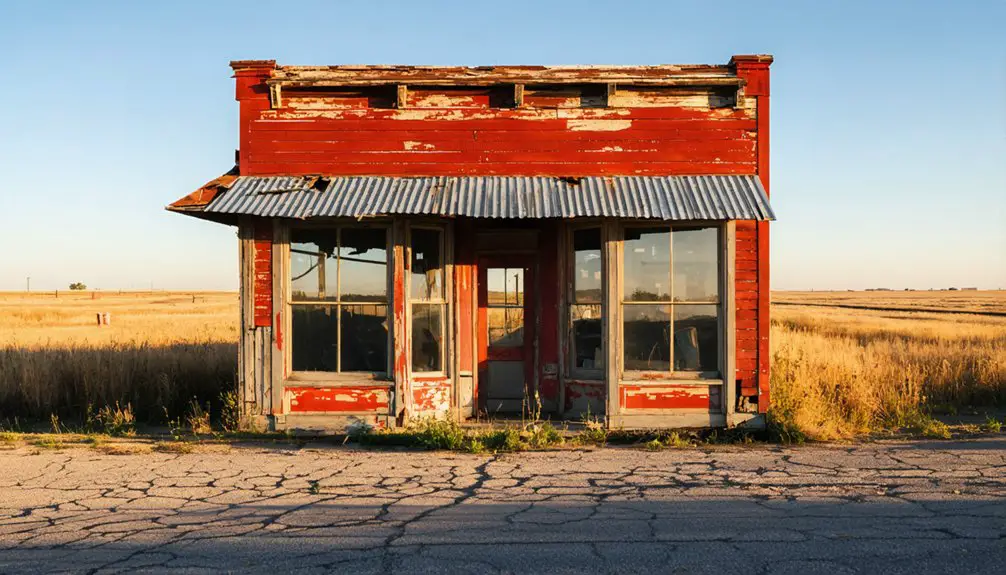You’ll find Pittsburg, Nebraska was a short-lived frontier town established in 1873 based on promising peat deposits. Originally planned as “Peatsburg,” the settlement gained a post office but struggled when the peat proved commercially unviable. Without railroad connections or diverse businesses, the town couldn’t sustain itself, and by 1875, residents had abandoned their claims. Today, only scattered foundation stones and subtle ground depressions mark where this ambitious venture once stood, each remnant telling a story of frontier dreams.
Key Takeaways
- Pittsburg was established in 1873 as a speculative venture based on peat deposits but failed when the resources proved commercially unviable.
- The town’s post office operated from 1873 to 1875, marking the brief period of its existence before abandonment.
- Economic failure stemmed from unrealized peat mining potential and lack of railroad connections to broader markets.
- Residents departed by 1875 due to harsh conditions, resource depletion, and absence of essential community infrastructure.
- Today, only scattered foundation stones and ground depressions remain where buildings once stood, now covered by agricultural fields.
The Birth of a Speculative Settlement (1873)
While many frontier towns emerged from natural growth or railroad expansion, Pittsburg, Nebraska began as a speculative venture in 1873, founded on the promise of abundant peat deposits in Seward County.
You’ll find the founder’s speculation centered on using peat as an alternative fuel source, similar to wood or coal, though historical records haven’t preserved their name.
The naming history reflects the settlement’s ambitious origins – it’s believed the founder initially intended to call it “Peatsburg,” highlighting the resource that drew them to the area.
The original name “Peatsburg” reveals the ambitious vision of a frontier town built on the promise of peat riches.
When the post office opened in 1873, it operated under the spelling “Pittsburgh,” though the town was officially recorded as “Pittsburg” without the ‘h’. Like many places sharing this name, it required precise disambiguation to distinguish it from other similarly named settlements.
The settlement’s establishment reflected the era’s spirit of resource-driven frontier development, much like the town of Pittsburg, Texas, which was named after the ambitious William Harrison Pitts family.
The Peat Promise That Never Was
Despite early promotional efforts touting Pittsburg’s rich peat deposits, the settlement’s economic foundation proved illusory.
What you’d have witnessed during this period of economic speculation was a rapid unraveling of the town’s peat extraction dreams.
You would’ve observed these stark realities:
- Geological surveys revealed the peat deposits weren’t commercially viable
- Essential processing infrastructure never materialized
- Early settlers abandoned their claims when the resource promises fell through
- Businesses tied to peat development shuttered their doors
Like many who faced similar disappointments in early Nebraska, the settlers were forced to seek opportunities elsewhere, much like the pioneers who filed the first homestead in 1870.
Life in Early Pittsburg
As settlers arrived in Pittsburg during 1873, you’d have found a community built entirely on the promise of peat mining, with daily life revolving around the arduous work of fuel extraction.
The community dynamics were minimal, with families focused on survival and cooperation rather than social development. You wouldn’t have found schools, churches, or social gathering places – just basic housing and peat processing facilities. Like many ghost towns in Nebraska, the settlement eventually faded into obscurity. The isolation was similar to what wagon freighting companies experienced along the Platte River in the 1850s.
Life’s daily challenges included harsh Nebraska weather, isolation, and limited access to supplies.
The town’s post office operated briefly from 1873 to 1875, providing a crucial link to the outside world.
As the peat deposits proved disappointing, you’d have witnessed the rapid exodus of residents seeking better opportunities elsewhere, leaving behind their dreams of establishing a thriving fuel-based economy.
The Short-Lived Postal Legacy
The establishment of Pittsburg’s post office in 1873 marked a curious chapter in the town’s brief history, operating under the spelling “Pittsburgh” rather than its common name.
You’ll find its postal significance reflected in the crucial community connections it fostered during its short two-year existence.
Similar to how Joseph Deroin’s trading brought commerce to early Nebraska settlements, the post office’s impact on daily life was profound, as shown by these essential functions:
- Served as the primary communication hub for settlers and businesses
- Provided official legitimacy to the emerging frontier settlement
- Connected residents to the outside world through mail service
- Facilitated trade and commerce between neighboring communities
When the post office closed in 1875, it signaled Pittsburg’s decline, reflecting the broader pattern of failed settlements in Nebraska’s early territorial period.
Without postal services, the town’s isolation deepened, hastening its eventual abandonment.
Economic Struggles and Abandonment
You’ll find that Pittsburg’s ambitious peat mining ventures collapsed quickly when the deposits proved inadequate for commercial exploitation.
The town’s fate was sealed by 1875 as residents and businesses departed, unable to sustain themselves on the limited natural resource that had initially drawn them there.
This resource-dependent settlement’s swift shift to abandonment mirrors the experience of many frontier towns that gambled their futures on speculative natural resources during Nebraska’s territorial period.
Peat Mining Prospects Failed
During the early 20th century, Pittsburg’s ambitious plans to establish a thriving peat mining industry met insurmountable challenges that ultimately contributed to the town’s downfall.
As America explored energy shifts, you’d find Pittsburg’s attempts at peat extraction repeatedly thwarted by harsh economic realities and technical limitations. While other regions thrived on Pittsburgh coal seam resources, Pittsburg, Nebraska’s gamble on peat proved disastrous. The use of steam shovels in other mining regions further highlighted Pittsburg’s technological disadvantages in peat extraction.
The town’s peat mining ventures failed due to:
- Coal’s superior energy density and established infrastructure made it more cost-effective
- Lack of specialized equipment and expertise for proper peat extraction
- High moisture content complicated processing and reduced fuel efficiency
- Transportation costs exceeded profitability, especially compared to nearby coal operations
Without government support or private investment, these challenges proved too severe.
The failed peat mining initiative left Pittsburg unable to sustain its economy, leading to its eventual abandonment and transformation into a ghost town.
Resource Depletion Drives Exodus
While Pittsburg’s failed peat mining ventures dealt the initial blow, widespread resource depletion across multiple sectors ultimately sealed the town’s fate. Like many Wild West towns, Pittsburg’s story reflected the broader pattern of resource-driven booms and busts.
You would’ve witnessed mounting resource scarcity as timber reserves dwindled, soil quality deteriorated, and water sources became harder to access. The harsh environmental conditions of Seward County only intensified these challenges.
As natural resources vanished, you’d have seen the population decline accelerate. Farmers couldn’t sustain their crops in the poor soil, while drought patterns made agriculture increasingly difficult.
Without viable economic alternatives or adequate infrastructure to support trade, residents had no choice but to seek opportunities elsewhere. By 1875, even the post office had closed, marking Pittsburg’s transformation into a ghost town.
Limited Commerce Sealed Fate
Despite initial hopes pinned on peat mining, Pittsburg’s commercial prospects crumbled rapidly between 1873 and 1875.
You’ll find that resource misestimation and lack of market demand doomed this frontier settlement from the start. The town’s economic struggles were evident in:
- Peat’s limited value compared to coal, making it commercially unviable
- Missing railroad connections that isolated the town from broader markets
- Absence of diverse businesses beyond basic peat extraction
- Loss of the post office by 1875, signaling commercial collapse
Without transportation infrastructure or alternative commerce options, you couldn’t sustain a thriving community here.
The town’s commercial viability vanished as residents sought opportunities elsewhere, transforming Pittsburg into another Nebraska ghost town – a stark reminder of frontier boom-and-bust economics.
A Lost Town’s Place in Nebraska History
As Nebraska’s ambitious settlement period reached its peak in 1873, Pittsburg emerged as one of many speculative towns hoping to capitalize on the state’s perceived natural resources.
The town’s Pittsburgh legacy, though brief, offers valuable insights into the patterns of Nebraska migration and settlement during the state’s formative years.
You’ll find Pittsburg’s story woven into the broader tapestry of Great Plains development, where towns rose and fell based on resource speculation.
While its peat deposits proved disappointing, the town’s short existence teaches important lessons about frontier economics and survival.
Today, Pittsburg stands as a reflection of the risks pioneers took in their quest for prosperity, contributing to our understanding of how environmental factors shaped Nebraska’s settlement patterns and community sustainability.
Archaeological Remnants and Historical Records
If you visit Pittsburg’s site today, you’ll find few visible remnants beyond scattered foundation stones and subtle depressions marking former building locations.
Historical records from Nebraska’s postal service confirm the town maintained an operational post office between the late 1800s and early 1900s, though exact dates remain uncertain due to incomplete documentation.
The combination of these physical traces and postal records provides tangible evidence of Pittsburg’s brief existence as a Nebraska settlement. Like the nearby ghost town of Amboy, the area features an old abandoned mill site that serves as a testament to its industrial past.
Physical Site Evidence Today
While most ghost towns retain visible structural remnants, Pittsburg, Nebraska’s physical evidence lies hidden beneath years of accumulated silt and soil.
Natural sedimentation effects have drastically reduced the archaeological visibility of this frontier settlement, making surface identification nearly impossible today.
If you were to visit the site, you’d find:
- A transformed landscape devoid of above-ground structures
- Agricultural fields where buildings once stood
- Deep soil deposits concealing potential 1870s artifacts
- No visible foundation outlines or structural features
Unlike other Nebraska ghost towns that showcase standing ruins, Pittsburg’s brief existence from 1873 to 1875 left minimal traces.
Modern development and farming practices have further altered the landscape, though buried archaeological deposits likely still contain ceramics, glass, and metal artifacts from this short-lived settlement.
Post Office Document Trail
Unlike the scarce physical remains at the site, documented evidence of Pittsburg’s existence can be found in postal records from 1873 to 1875.
You’ll find the town’s brief life reflected in postal archives, where it’s listed under “Pittsburgh” with an “h” – a spelling variation that differs from most historical references. This discrepancy adds complexity to ghost town documentation efforts, requiring researchers to check multiple spellings when searching historical records.
While detailed operational logs haven’t survived, U.S. Geological Survey records and postal history registers confirm both the establishment and closure dates of the post office.
These dates align perfectly with the town’s founding and abandonment, making postal records one of the most reliable sources for verifying Pittsburg’s short-lived existence.
Frequently Asked Questions
Were There Any Major Crimes or Notable Incidents During Pittsburg’s Brief Existence?
Zero crimes were recorded in the town’s two-year existence. You won’t find any crime history or notable incidents during this period – just a swift economic decline from failed peat mining.
What Happened to the Original Settlers After They Left Pittsburg?
You’ll find most settlers migrated to nearby prosperous towns, adapting to economic impacts by taking up farming, ranching, or railroad jobs. Some moved further west, while others returned east.
Did Any Other Towns Develop Near Pittsburg’s Original Location?
You won’t find any documented nearby settlements or town development after the site’s abandonment. Records show the area remained largely undeveloped, with regional growth focusing on more established communities elsewhere in Seward County.
Were There Any Known Burial Grounds or Cemeteries in Pittsburg?
You won’t find documented cemetery locations or burial rituals for this site in historical records. Despite most ghost towns having known burial grounds, there’s no clear evidence of any in Pittsburg.
What Was the Peak Population of Pittsburg During Its Short Existence?
You’ll find that no exact peak population records exist, but based on town history and regional patterns, Pittsburg’s population likely never exceeded 100 residents during its brief 1870s existence.
References
- https://en.wikipedia.org/wiki/Pittsburg
- https://www.youtube.com/watch?v=tJWaL6_ovK8
- https://www.onlyinyourstate.com/trip-ideas/nebraska/ne-ghost-towns-road-trip
- https://www.youtube.com/watch?v=redtU6GT-BY
- https://kids.kiddle.co/Pittsburg
- https://ohioghosttowns.org/county-data-charts/
- http://www.kancoll.org/books/andreas_ne/butler/butler-p4.html
- https://www.gutenberg.org/files/34844/34844-h/34844-h.htm
- https://www.ou.edu/content/dam/archsurvey/docs/archsur-Sites_By_County.pdf
- https://pubs.usgs.gov/bul/0285f/report.pdf



